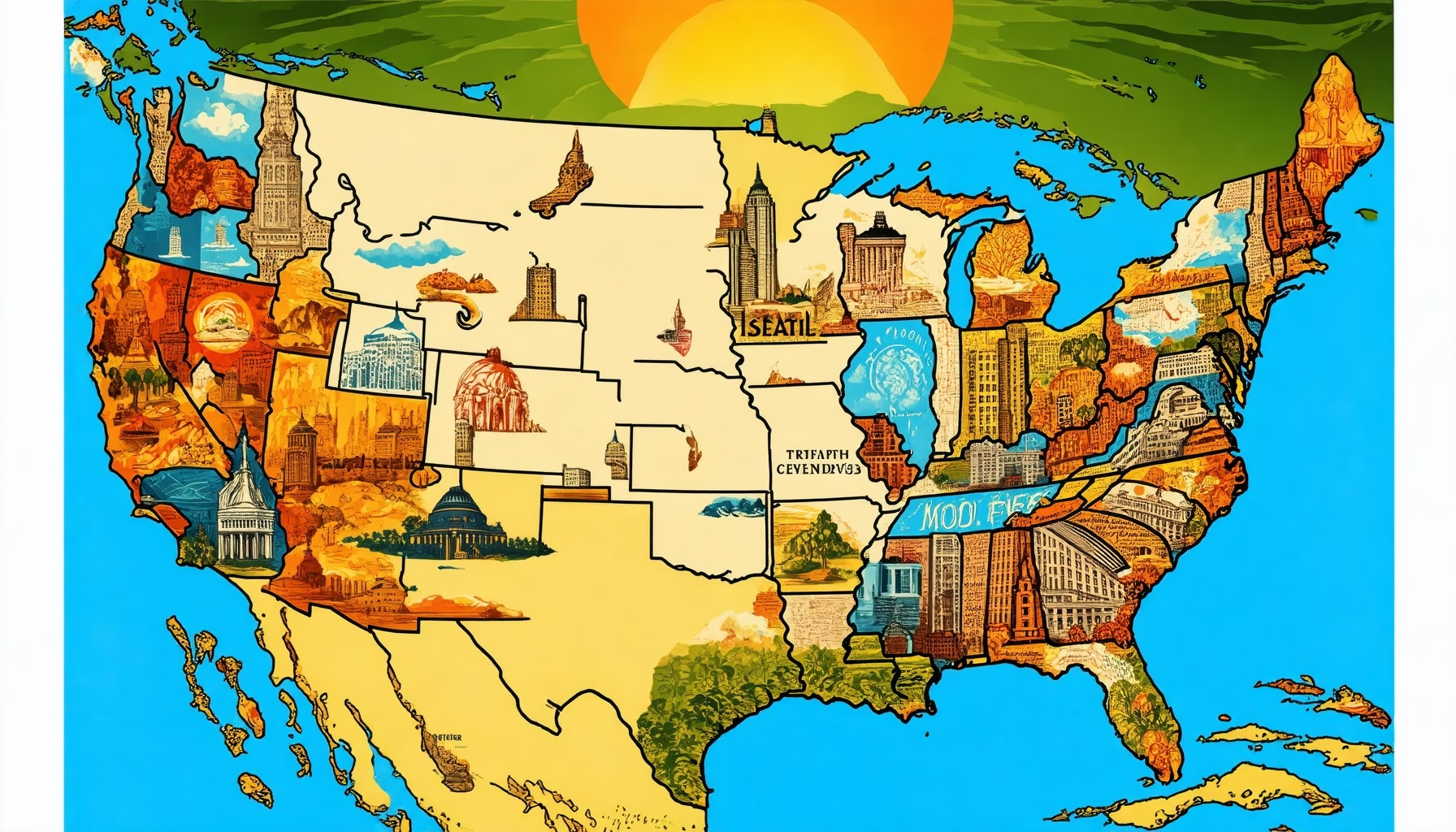Key Takeaways
- California leads in government assistance by state, providing extensive welfare programs, healthcare services, and housing support.
- States like New York and Texas also offer substantial government aid, benefiting from various federal and state programs.
- Poverty rates and population size are key factors influencing the level of government assistance available in each state.
- Vermont is recognized for having the most generous welfare programs, with comprehensive Medicaid coverage and extensive support services.
- Hawaii provides the highest SNAP benefits per household member, reflecting its high cost of living compared to other states.
- Understanding the dynamics of federal assistance and donor vs. taker states is crucial for effective economic planning and resource allocation.
In today’s complex economic landscape, understanding government assistance by state is crucial for individuals and families seeking support. This article delves into the intricate world of government aid by state, exploring which states offer the most aid and benefits. We will begin by examining what state gives the most government assistance, highlighting key factors that influence assistance levels across the nation. Next, we will analyze which states get the most federal assistance, providing a comprehensive overview of federal funding distribution. Additionally, we will discuss which states give more than they take, revealing the dynamics of donor versus taker states. Furthermore, we will evaluate which US state has the best welfare and the most generous SNAP benefits, shedding light on government assistance programs by state. Finally, we will conclude with insights on current trends in government assistance usage by state and future projections. Join us as we navigate the landscape of government assistance in the United States and uncover the vital information you need to make informed decisions.
What state gives the most government assistance?
The state that provides the most government assistance varies based on the type of aid considered, but generally, California is often cited as a leader in total government assistance due to its extensive welfare programs, healthcare services, and housing support. According to the U.S. Census Bureau, California spends significantly on social services, including Medi-Cal, which is the state’s Medicaid program, and CalWORKs, which provides cash assistance to low-income families.
In addition to California, states like New York and Texas also offer substantial government assistance. New York, for instance, has robust programs for food assistance, housing, and healthcare, while Texas has a large number of residents benefiting from various federal and state aid programs.
Overview of Government Assistance by State
Government assistance by state encompasses a variety of programs designed to support individuals and families in need. These programs can include healthcare, food assistance, housing support, and cash benefits. The level of government aid by state is influenced by several factors, including the state’s economic conditions, population demographics, and specific policies aimed at addressing poverty and welfare.
For example, California’s extensive government assistance programs reflect its large population and high cost of living, necessitating significant investment in social services. Similarly, states with higher poverty rates often receive more federal funding to support their residents, which can lead to a greater overall level of government assistance. Understanding government assistance usage by state is crucial for identifying which areas require more support and how resources can be allocated effectively.
Key Factors Influencing Government Assistance Levels
Several key factors influence the level of government assistance available in each state:
- Population Size: Larger states tend to have more resources allocated to assistance programs, resulting in higher levels of government aid.
- Poverty Rate: States with higher poverty rates often receive more federal funding to support their residents, leading to increased government assistance.
- State Policies: Each state’s approach to welfare and assistance programs can greatly affect the level of support available, with some states prioritizing social services more than others.
For more detailed information on government assistance programs, you can refer to resources such as the government benefits information and the government assistance programs by state, which provide comprehensive data and analysis on state assistance programs.
Which States Get the Most Federal Assistance?
Understanding which states receive the most federal assistance is crucial for grasping the broader landscape of government aid in the United States. Federal assistance is vital for states with higher poverty rates, larger populations, and greater reliance on federal programs. According to recent data from the U.S. Census Bureau and the Federal Funds Information for States (FFIS), the following states consistently rank among the highest in federal assistance per capita:
- California: With a large population and significant social service needs, California receives substantial federal funding for healthcare, education, and social services.
- Texas: Texas benefits from federal funds for disaster relief, healthcare, and education, reflecting its vast size and diverse needs.
- New York: High levels of federal assistance in New York are driven by its large urban population and extensive public services.
- Florida: Florida receives considerable federal support, particularly for healthcare programs like Medicaid, due to its large elderly population.
- Kentucky: Kentucky often ranks high in federal assistance due to its economic challenges and reliance on programs like SNAP (Supplemental Nutrition Assistance Program).
Federal assistance encompasses various programs, including Medicaid, Social Security, and education funding, which are crucial for supporting state budgets and services. According to the National Association of State Budget Officers (NASBO), federal funds account for a significant portion of state revenues, particularly in states with lower income levels.
For a comprehensive understanding of federal assistance distribution, the Government Accountability Office (GAO) provides detailed reports and analyses that highlight trends and impacts of federal funding across states.
Federal Funding by State Per Capita: Understanding the Distribution
Analyzing federal funding by state per capita reveals significant disparities in how government assistance is allocated. States with higher federal assistance per capita often have a greater percentage of people on government assistance. This distribution is influenced by several factors, including economic conditions, population demographics, and state policies regarding welfare and social services.
For instance, states like California and New York not only receive high levels of federal funding but also have extensive government assistance programs that cater to diverse populations. In contrast, states with lower federal assistance per capita may have more robust economies or fewer residents relying on government aid.
Understanding the government assistance programs by state can provide insights into how these funds are utilized and the impact on local communities. Additionally, examining the government aid by state can help identify which programs are most effective in addressing the needs of residents.
Which States Give More Than They Take?
Understanding the balance between federal taxes paid and federal spending received is crucial when discussing government assistance by state. States that contribute more in taxes than they receive in federal funding are often referred to as “donor states.” This section explores the dynamics of donor states and their contributions to the federal system.
List of Donor States vs Taker States: Who Contributes More?
Several states consistently rank as donor states, meaning they pay more in federal taxes than they receive in federal assistance. Here are some key examples:
- New Jersey: Known for its high income levels, New Jersey contributes significantly more in federal taxes than it receives in federal spending, making it one of the top donor states.
- Connecticut: Similar to New Jersey, Connecticut’s residents pay substantial taxes, resulting in a net outflow of federal funds.
- Massachusetts: With a strong economy, Massachusetts also ranks as a donor state, contributing more in taxes than it receives in federal assistance.
- Virginia: Although Virginia benefits from federal funding due to numerous federal agencies, it still contributes more in taxes overall.
- New York: Often cited as a donor state, New York’s residents pay significantly more in federal taxes than the state receives in federal spending.
These states illustrate the ongoing debate about federal government assistance by state and the implications for economic planning and budget allocations.
Which States Pay the Most Federal Taxes and Get the Least Back?
In addition to the donor states mentioned, it’s essential to consider the states that pay the most in federal taxes while receiving minimal federal assistance. This dynamic can impact the government assistance programs by state and the overall economic health of these regions. States like New Jersey, Connecticut, and Massachusetts not only contribute significantly in taxes but also receive less in terms of government aid by state. This disparity raises questions about the fairness of federal funding distribution and its effects on state budgets.
For a deeper understanding of the financial dynamics at play, including the federal taxes paid by state vs received list, resources like the U.S. Census Bureau and the Tax Foundation provide comprehensive analyses of state contributions and federal spending.
Which State Contributes the Most to the US Government?
When examining government assistance by state, it’s essential to recognize which states contribute significantly to the federal budget. California stands out as the largest “donor state” in the United States. In 2022, California contributed an impressive $692 billion in federal taxes, far exceeding the $609 billion it received in federal funding. This results in a net contribution of approximately $83 billion, highlighting California’s critical role in supporting federal programs and services across the nation.
The Rockefeller Institute’s dataset illustrates that California’s economy, driven by its diverse industries including technology, entertainment, and agriculture, plays a pivotal role in generating substantial tax revenue. The state’s high-income earners and large population contribute to its status as a major financial powerhouse. This trend of California being a donor state has been consistent over the years, reflecting the state’s economic strength and the disparities in federal funding allocation among states. For further insights, the U.S. Census Bureau and the Bureau of Economic Analysis provide additional data on state contributions and federal funding dynamics.
Federal Taxes Paid by State vs Received List: A Detailed Breakdown
Understanding the federal taxes paid by state versus the federal funding received is crucial for grasping the dynamics of government assistance by state. This breakdown reveals significant disparities among states, with some contributing far more than they receive. For instance, states like New York and New Jersey also rank high in terms of net contributions, while states such as Mississippi and West Virginia often receive more federal assistance than they contribute.
This imbalance can be attributed to various factors, including population size, income levels, and economic activity. States with larger populations and higher income levels tend to pay more in federal taxes, while those with lower economic activity often rely more heavily on federal government assistance. To explore specific figures and comparisons, the official U.S. government website offers comprehensive resources on federal funding and state contributions.
The Impact of State Contributions on Federal Aid Distribution
The contributions of each state significantly impact the distribution of federal aid across the United States. States that contribute more in federal taxes often advocate for policies that ensure their contributions are recognized and utilized effectively. Conversely, states that receive more federal assistance may depend on these funds to support essential services and programs.
This dynamic creates a complex relationship between donor and recipient states, influencing legislative priorities and funding allocations. For example, California’s substantial contributions enable it to push for more tailored federal assistance programs that address its unique needs, such as housing and education. Understanding these relationships is vital for comprehending the broader landscape of government assistance usage by state.
Which US State Has the Best Welfare?
When evaluating which US state has the best welfare programs, Vermont consistently ranks as the most generous. According to recent analyses, the average low-income individual in Vermont receives approximately $26,000 in benefits annually. This high level of support is primarily attributed to Vermont’s robust Medicaid program, which is one of the most comprehensive in the nation, covering a significant portion of low-income residents.
Government Assistance Programs by State: Evaluating Welfare Systems
Several factors contribute to Vermont’s welfare generosity:
- Medicaid Coverage: Vermont’s Medicaid program provides extensive health coverage, accounting for nearly half of the total welfare benefits distributed. This program not only covers medical expenses but also includes preventive care, mental health services, and long-term care, ensuring that low-income individuals receive comprehensive support.
- Supplemental Nutrition Assistance Program (SNAP): Vermont offers substantial assistance through SNAP, helping families afford nutritious food. The state has made efforts to increase access to these benefits, particularly for vulnerable populations.
- Housing Assistance: The state provides various housing assistance programs aimed at preventing homelessness and ensuring stable living conditions for low-income families. This includes rental assistance and support for affordable housing initiatives.
- Child Care Subsidies: Vermont also invests in child care subsidies, which help low-income families afford quality child care, allowing parents to work or pursue education without the burden of high child care costs.
- Employment Support Programs: The state offers job training and employment support services, helping individuals gain skills and find stable employment, which is crucial for long-term financial independence.
Government Assistance Usage by State: Trends and Insights
In summary, Vermont’s welfare system stands out due to its comprehensive Medicaid program, extensive food assistance, housing support, child care subsidies, and employment services. These elements collectively contribute to a supportive environment for low-income residents, making Vermont a leader in welfare generosity in the United States. For further details on state welfare programs, you can refer to the U.S. Department of Health & Human Services and the Center on Budget and Policy Priorities for authoritative insights.
Which State Has the Most Generous SNAP Benefits?
When examining government assistance by state, Hawaii stands out as the leader in providing the most generous SNAP benefits. For fiscal year 2023, the average monthly benefit is $385 per household member. This figure is significantly higher than many other states, reflecting Hawaii’s high cost of living. In contrast, states like Mississippi and Arkansas offer average monthly benefits that are nearly half of what Hawaii provides, showcasing the disparities in government assistance across the United States.
Government Assistance Per Capita by State: SNAP Benefits Overview
In addition to Hawaii’s generous SNAP benefits, it’s essential to consider the overall government assistance per capita by state. States like California, which had approximately 4.6 million individuals enrolled in SNAP in fiscal year 2022, demonstrate a significant reliance on government aid. This high participation rate indicates not only the state’s efforts to support low-income families but also the challenges they face with rising living costs. Understanding the number of people on government assistance by state can provide insights into the economic landscape and the effectiveness of government aid programs.
Number of People on Government Assistance by State: A Closer Look
The percentage of people on government assistance by state varies widely, influenced by factors such as economic conditions, unemployment rates, and state policies. For instance, states with higher poverty rates often see a larger proportion of their population relying on government aid. Resources like Benefits.gov offer comprehensive information on eligibility and application processes for various assistance programs, including SNAP. Additionally, platforms like Gov Guider can help individuals navigate their local SNAP programs and understand their entitlements.
Government Assistance by State: Conclusion and Future Trends
Understanding government assistance by state is crucial for identifying how resources are allocated across the United States. As we analyze current trends, it becomes evident that various factors influence the levels of government aid by state, including economic conditions, population demographics, and state policies. This section delves into the current statistics regarding the number of people on government assistance by state and provides an overview of government farm subsidies by state.
People on Government Assistance by State: Current Statistics
As of the latest data, approximately 12% of the U.S. population relies on some form of government assistance. States like California and New York have the highest numbers of individuals receiving aid, largely due to their larger populations and higher living costs. For instance, California reports over 4 million people on government assistance programs, while New York follows closely with around 3 million. This reflects a significant percentage of people on government assistance by state, highlighting the need for continued support and resources.
Moreover, states such as Mississippi and Arkansas show higher rates of assistance relative to their population size, indicating a greater dependency on federal and state aid. This trend emphasizes the importance of understanding government assistance usage by state to address the unique needs of each region effectively.
Government Farm Subsidies by State: An Overview of Agricultural Support
Government farm subsidies by state play a vital role in supporting agricultural economies, particularly in rural areas. States like Iowa, Texas, and Illinois receive substantial federal subsidies aimed at stabilizing farm income and promoting agricultural production. For example, Iowa alone received over $1 billion in subsidies in recent years, reflecting its status as a leading agricultural state.
These subsidies not only assist farmers but also contribute to the overall economic stability of these regions. Understanding the distribution of federal government subsidies by state is essential for evaluating how agricultural policies impact local economies and food security. As we move forward, it will be crucial to monitor these trends and their implications for both farmers and consumers alike.




